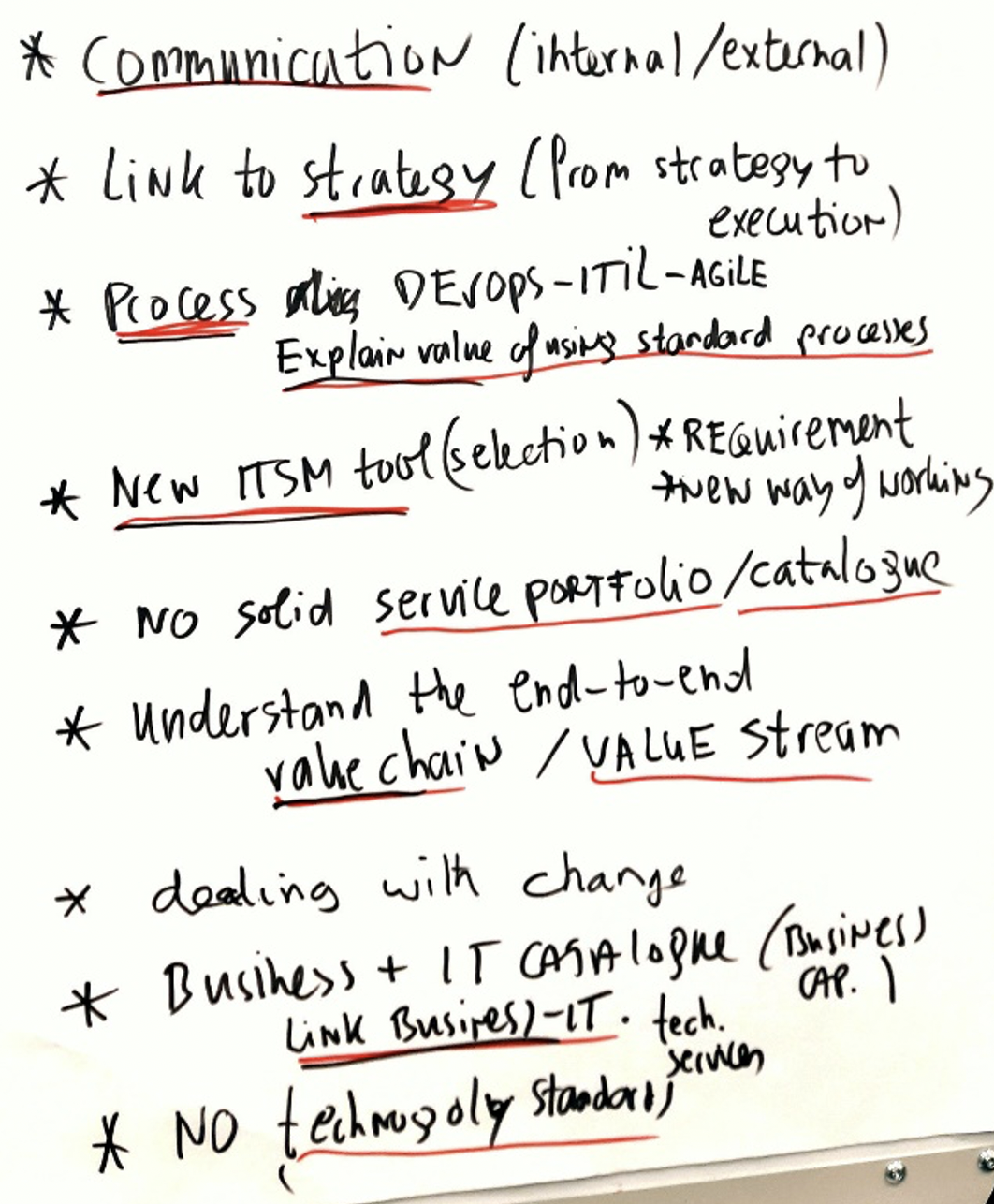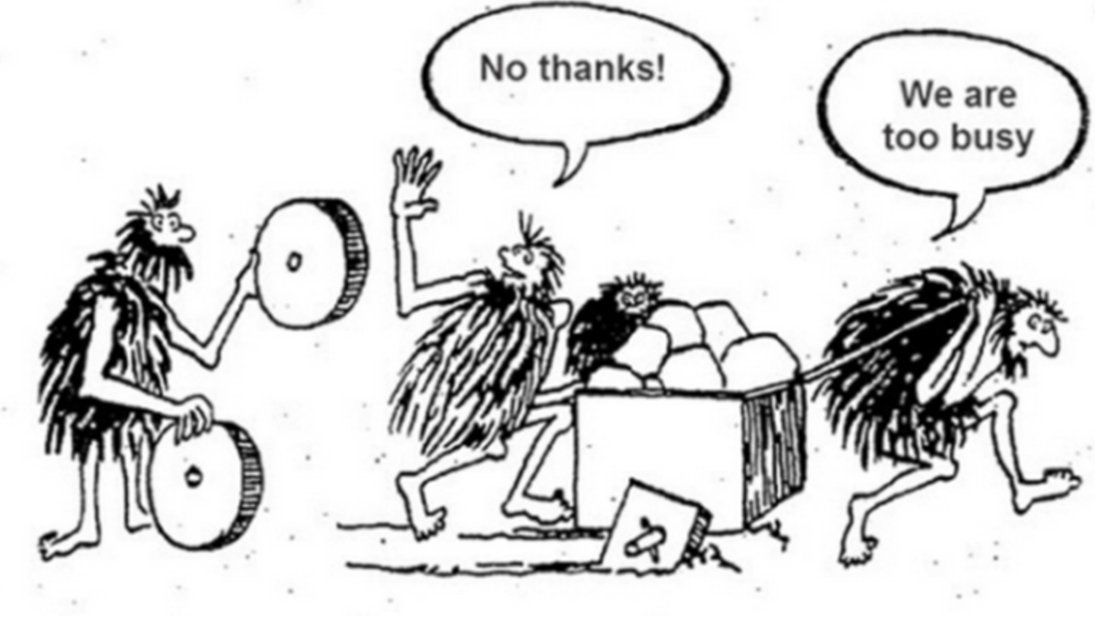Publikováno: 24. 4. 2023
Fail fast but gracefully in IT service management
A summary of the Prague Dialogue, January 2023
Part 2. Concerns at work

The concerns are listed in three groups:
- Products and value
- Processes and change
- Tools.
2.1 Products and value
Strategic alignment
This concern was that operational functions where the real work is done, are working towards operational goals that are poorly aligned with strategic goals. It is also about understanding and aligning with the purpose of the organization, and understanding how the initiatives support the strategic intent and direction.
Mission statements and strategic principles are often unclear and misunderstood (vague slogans that cannot be translated into execution or actual behaviour). Vladimir Kufner and Patrik Šolc proposed a bad practice: “Slogans instead of real transformation”.
In some cases, operational goals are sometimes not even poorly aligned but are non-existent. This has an indirect impact on people’s performance and sense of connection with the company in general. So even slogans with limited value may be better than nothing.
This concern is related to another point, “Communication”.
Service portfolio/catalogue
There is no “single source of truth” as to which products and services are available.
The views of the services are not tailored to the various groups of stakeholders, for example making the distinction between IT services for business users and IT services for IT users.
The connection between IT services and the supported business functions. Often it is not clear how IT services and products enable the business processes to deliver value to their customer (e.g., linking customer journeys, value streams and business processes to the IT services and underlying platform services). No clear mutual understanding between the business and IT as to how IT enables the business.
This is related to communication and collaboration, and the organizational units realizing that everyone provides service to someone and that service management is all around us. At certain points (especially when major incidents occur) we come to realize very quickly that we depend on one another, but we tend to quickly forget about it once the incident has been dealt with. Lack of continuous improvement in these areas create a world where organization units are isolated in their silos, searching for the “Shiny New Thing that Really Helps.” Different organization units use different terminologies and frameworks but at the end of the day we are talking about the same things. In order for this to improve, organizational units need to spend more time talking among themselves and figuring out that they cannot function without the other. It’s not about IT, HR, Legal, Procurement, Facilities, etc. Everyone delivers services and it is only when they work together that they create value. Which is the point of co-creation after all.
This impacts both “Communication” as well as “Strategic alignment”. Also see “End-to-end value chains”.
2.2 Processes and change
Processes
The context for this concern was collaboration between process-oriented IT service management functions and functions that work with Agile or DevOps approaches where the ways of working seem less formal. The concern is that it is difficult to explain the value of standard processes (and practices) so these functions see the value of a standard way of working.
For example, DevOps teams don’t want to log every incident, maintain the knowledge base, register changes in the ITSM-system, etc.
End-to-end value chains
People have limited visibility of, and connection with, other parts of the value chain. Often, nobody is responsible for the end-to-end chain. This makes it difficult to prioritize, and to limit value leakage. The consequence is not only poor throughput but also poor employee engagement due to lack of feedback from the end user and other parties in the value chain.
This concern is related to the concerns about communication, processes, and strategic alignment.
Communication
It will not come as a surprise to learn that communication was a concern. This basic skill is lacking in most organizations. The participants were concerned about communication between IT and IT functions, between IT and business functions, and between IT and external IT service providers. Communication with external customers was less applicable to their context.
Communication is often vertical and hierarchical, moving across multiple management layers (both downstream and upstream) resulting in miscommunication and confusion.
Communication is not just about providing information to stakeholders – it starts with understanding what information the consumer actually needs (know your customer).
Communication is bi-directional.
“Communication is about speaking to people, not at them.” – Kaimar Karu
Dealing with change
The ability of the organization to adapt to change was a concern. For example, reorganizations never finish properly and on-time, because conditions change.
Change is a fact of life, but people struggle with the uncertainties it brings. On the other hand, people like change if it reduces friction and improves their employee experience and job safety.
Dealing with change is also hard for facilitators to manage. Management oftentimes wants changes to be implemented immediately without even thinking about the impact. On the other hand, many employees often tend to resist any sort of change. They would rather work ten times longer with their manual processes than let us help them automate routine tasks. These very human characteristics are usually a problem.
2.3 Tools
Tool selection
It is hard to establish what the various stakeholders want and need from ITSM tools It is not only about gathering requirements for selection but also includes agreeing on a way of working with the tool. The concern is not only the time it takes but also whether the tool will be accepted and used effectively.
The introduction of a new tool is more about enabling the transformation (e.g., transforming IT processes and introducing new ways of working), than just selecting and implementing a new tool.
It is often times complicated to explain the real value of a new tool to the workforce and management. Tool vendors’ marketing campaigns tend to promise big savings, yet in reality calculating the ROI is much harder. Managers therefore often overlook the bigger picture, because, naturally, their main concern is to spend as little as possible. The users, on the other hand, care more about the functionality rather than the resources. Finding the best of the both worlds is an art on its own.
Another problem with tools is that in an environment with lots of autonomy, the company might have several toolsets for the same purpose. This not only has direct financial consequences, but also indirectly for data exchange, integration, etc. Breaking down silos is hard when everyone – understandably – thinks their tool is the best one and there is no architectural function that imposes some form of standardisation.
Finally, users often do not have time to adopt new tools, as illustrated by the cartoon below.

Technology standards
Organizations struggle with the diversity of the technologies that they have adapted over time, and their apparent inability to prevent and reduce complexity. This also results in challenges such as technology debt (and technology refresh).
Most organization still lack a standard set of reusable technology building blocks (often referred to as “platform services”) which enables teams to deliver faster and safer, while reducing risks and costs.
get back to p. 1 or continue to p. 3
Autor:: Martin Kubeš